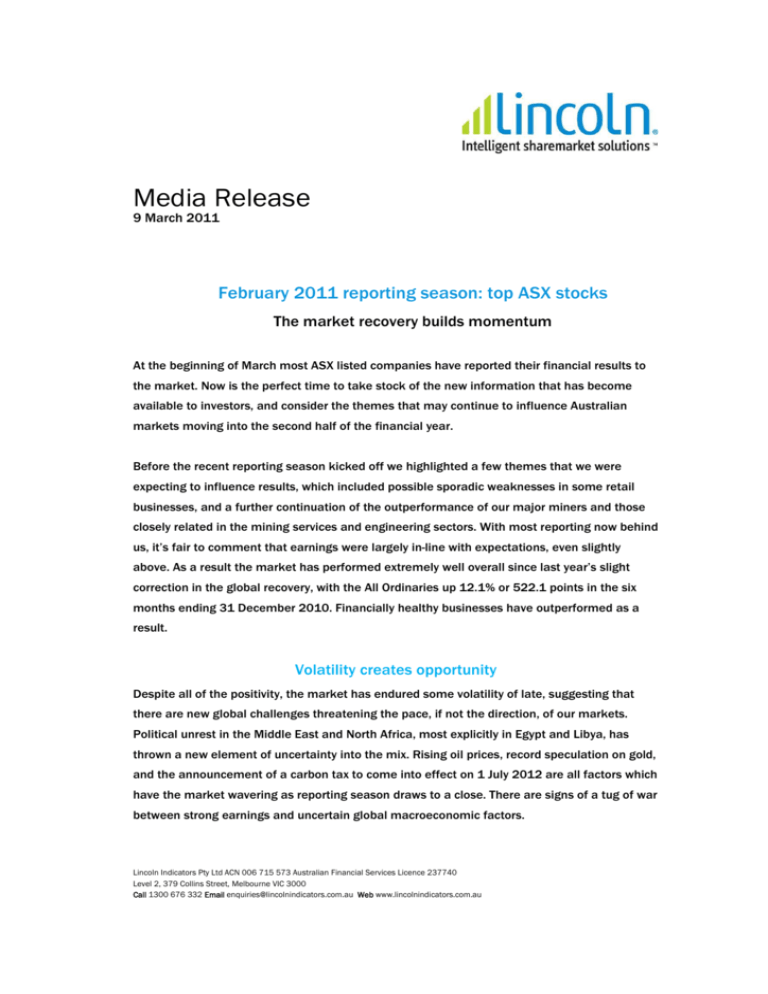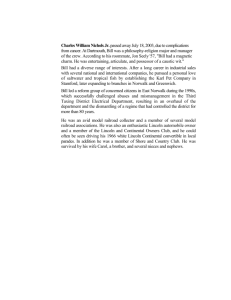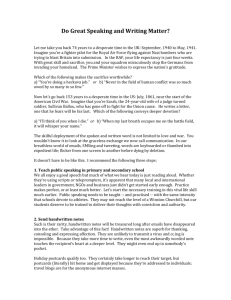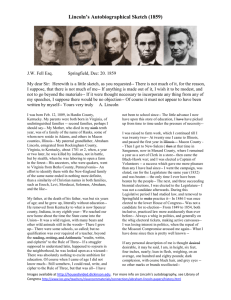
Media Release
9 March 2011
February 2011 reporting season: top ASX stocks
The market recovery builds momentum
At the beginning of March most ASX listed companies have reported their financial results to
the market. Now is the perfect time to take stock of the new information that has become
available to investors, and consider the themes that may continue to influence Australian
markets moving into the second half of the financial year.
Before the recent reporting season kicked off we highlighted a few themes that we were
expecting to influence results, which included possible sporadic weaknesses in some retail
businesses, and a further continuation of the outperformance of our major miners and those
closely related in the mining services and engineering sectors. With most reporting now behind
us, it’s fair to comment that earnings were largely in-line with expectations, even slightly
above. As a result the market has performed extremely well overall since last year’s slight
correction in the global recovery, with the All Ordinaries up 12.1% or 522.1 points in the six
months ending 31 December 2010. Financially healthy businesses have outperformed as a
result.
Volatility creates opportunity
Despite all of the positivity, the market has endured some volatility of late, suggesting that
there are new global challenges threatening the pace, if not the direction, of our markets.
Political unrest in the Middle East and North Africa, most explicitly in Egypt and Libya, has
thrown a new element of uncertainty into the mix. Rising oil prices, record speculation on gold,
and the announcement of a carbon tax to come into effect on 1 July 2012 are all factors which
have the market wavering as reporting season draws to a close. There are signs of a tug of war
between strong earnings and uncertain global macroeconomic factors.
Lincoln Indicators Pty Ltd ACN 006 715 573 Australian Financial Services Licence 237740
Level 2, 379 Collins Street, Melbourne VIC 3000
Call 1300 676 332 Email enquiries@lincolnindicators.com.au Web www.lincolnindicators.com.au
These themes were not unexpected here at Lincoln, as Chief Executive Officer, Elio D’Amato
mentioned in our reporting season preview, “Oil will be a major commodity theme for the next
six months...Liquefied natural gas (LNG) is less attractive as a commodity growth theme with
too much supply coming on stream.” As we’ve seen, this is how things are playing out, and
perhaps the comparative weakness in gas prices explains why we have yet to see any energy
companies become new Lincoln Star Stocks this period. The major energy companies in
Australia, such as Woodside Petroleum Limited (WPL), Origin Energy Limited (ORG) and
Santos Limited (STO) tend to have some sizeable LNG exposure, thus the benefits of a rising
oil price may not be apparent.
So whilst global caution may be continuing and volatility is increasing, we feel now, as always,
volatility creates opportunities.
Two-speed economy
The now notorious two-speed economy appears set to continue after this reporting season’s
results, with many miners reporting bumper profits. In fact, it would appear the gap was wider
than first thought based on the trend of recent results. BHP Billiton Limited (BHP), RIO Tinto
Limited (RIO), Fortescue Metals Group Limited (FMG), and many others posted record, or near
record profitability. As such there was an influx of new Star Stocks in this sector. We have
mentioned previously that much of this can be attributed to record high spot prices in iron ore,
gold, and copper being recorded during the six months to 31 December 2010. With
commodity prices and associated profits so high, it was inevitable that we would see a
continuation of the strong performance in businesses servicing our mighty miners.
Monadelphous Group Limited (MND) continued to perform with another strong result, and
Forge Group Limited (FGE) and Decmil Group Limited (DCG) also added to the momentum.
Notably, more miners have commenced, or recommenced, paying dividends as a result of this
season’s bumper profits. Whilst this has been combined with new found appetites amongst
companies to engage in share buyback schemes as a means of returning funds to
shareholders, it is possible that some of the major mining companies such as BHP and RIO are
retaining significant cash holdings in order to take advantage of any acquisition opportunities
that present themselves in the second half or beyond.
On the ‘slower’ side of the two-speed economy, we saw mixed results from our retailers and
consumer discretionary businesses. It became clear early on that times were tough, as
deflation, discounting, and poor consumer conditions coupled with wet weather and
environmental disasters provided the perfect storm for the Christmas run-in. Many seasonal
businesses were impacted however as always, there were a few diamonds in the rough. Those
2
businesses that are differentiated either by a niche offering or strength in buying power
reported generally pleasing results under adverse conditions. JB Hi-Fi Limited (JBH) remains a
good example of where buying power and a strong product mix has enabled the business to
ward off macroeconomic pressures, and the company has posted a pleasing result. However
ruthless consumers seeking online bargains exposed vulnerabilities amongst many businesses
including Harvey Norman Holdings Limited (HVN) and Myer Holdings limited (MYR) who all had
disappointing results.
As quoted by Elio D’Amato in our reporting season preview, Health care stocks were tipped to,
“see continued share price underperformance despite top and bottom-line growth in reality
due, once again, to the impact of a strong Australian dollar, or at least the perception of an
impact.” As suspected, CSL Limited (CSL) underlying bioplasma operations posted a good
result, although was somewhat diluted by currency headwinds.
Despite tightening purse-strings in the retail environment, the Telecommunications sector was
again a mixed bag of results. Telstra Corporation Limited (TLS) delivered some further
disappointing results, however these were largely in-line with expectations. With TLS
representing around 80% of the Telecommunications sector, it appears to drag like-businesses
down with them. As we have said before, when TLS sneezes the telecoms sector catches a
cold. Despite the weak lead from TLS, many reported pleasing results with M2
Telecommunications Group Limited (MTU), Macquarie Telecom Group Limited (MAQ), and TPG
Telecom Limited (TPM) the standouts. Due to the impact of recent acquisitions iiNet Limited
(IIN) was removed as a Star Stock, however with a good profit performance and a recent
Australian Competition and Consumer Commission (ACCC) ordered reduction in wholesale
fixed line costs, we expect that IIN will continue to grow and perform in the future.
Telecommunications has further suffered at the hands of the uncertainty created by the
planned rollout of the National Broadband Network (NBN), and many stocks are trading at
prices depressed compared to their valuations.
Australian banks reported well this season, and managed to improve lending margins despite
the increasing costs of funding. Although profits appeared to grow from the banks, these
strong results - Commonwealth Bank of Australia (CBA) was particularly strong with record
profits - are largely attributed to a reduction in bad and doubtful debts. Growth of this nature is
less reflective of strong operational performance, and more reflective of a healthier than
estimated Australian economy.
And finally, our much maligned insurers have done it tough once again, with the effects of
various weather events relentlessly putting businesses like Suncorp Group Limited (SUN), QBE
Insurance Group Limited (QBE) and Insurance Australia Group Limited (IAG) under the
3
microscope. All showed encouraging signs of their ability to cope with increased claims activity
and were well equipped with reinsurance protection, which significantly limited losses.
Looking forward, Australian insurers may feel the pinch of rising reinsurance premiums, and
the nervousness of knowing that their provisions for these events have already been reached
by the disasters that the first half of the year has seen. Needless to say, the stakes are raised
moving into the second half of the year.
As investors, what have we learnt from the recent reporting season:
x
Opportunities: As always the reporting season throws up opportunities, and this year is no
exception. Look for stocks that have a strong earnings record and a largely positive
outlook, but flagged below-expectation guidance. This will create the opportunity
x
Diversify: With the continuation of the two-speed economy it is very easy to forget to
diversify your portfolio, and sector exposure should always be considered
x
Economic health: Results of most retailers have showed that the Australian economy is
still in good health, however selecting a strong business in adverse consumer conditions
remains the key to successful investing
x
Long term investing: Banks and Insurance companies are in solid shape however growth
prospects for the short term are less than ideal
Lincoln’s top ten winners from this reporting season
Utilising our unique research methodology, here at Lincoln we have identified ten winners from
the February reporting season which we believe are quality, long-term opportunities and
currently hold a Lincoln Financial Health rating of ‘Strong’ or ‘Satisfactory’:
1. M2 Telecommunications Group Limited (MTU):
MTU repackages and resells fixed line, mobile and data services to small and medium
enterprises. The company is in a Satisfactory position of Financial Health, and is experiencing
solid levels of organic growth and growth through acquisition. MTU has become a leader in its
niche of the telecommunications provider market, and although its business model is low
margin, they are finding great success in providing better service to this niche than most
competitors. MTU upgraded its profit guidance on 7 March 2011 by around 20% on the back
of reduced costs of wholesale line rental, after already reporting EPS growth of 24.63% in the
December interim period.
4
2. REA Group Limited (REA):
REA is responsible for the well known property advertising site realestate.com.au, and
experienced good levels of growth in the period. Revenues were up 24.5% and net profits up
35%, in what was a softer period for Australian housing prices. With healthy contributions to
revenues and a growing footprint in Italy, prospects for further international expansion remain
strong. REA is in a Strong position of Financial Health, and is a consistent performer.
3. Credit Corp Group Limited (CCP):
CCP is building a team experienced in collections, and this is assisting them in improving their
success rates. The company has learnt its lesson from the pre-GFC era and is more selective in
the debt they are purchasing. This discipline has resulted in improved collection efficiency that
has assisted the bottom line result, and saw a 51.32% growth in EPS. CCP is in a Strong
position of Financial Health, and recently increased its interim dividend, from 3 to 10 cents (an
increase of 233%).
4. Fortescue Metals Group Limited (FMG):
A lot of things went right for FMG in the six months ending 31 December 2010, and its half
yearly report reflected this. Given FMG offers investors pure exposure to iron ore an
encouraging point for shareholders was not just the profitability, but the announcement of a
maiden dividend of five cents per share. Compounding the positive period for FMG, the
company announced that they have discovered another billion tonne deposit of iron ore in the
Pilbara. The company is in a Strong position of Financial Health and has high ambitions for
future expansion to production levels.
5. JB Hi-Fi Limited (JBH):
JBH delivered another strong result with EPS growth of 15.38% on the back of higher revenue
in a retail environment characterised by price deflation and heavy promotional activity. Gross
margin increased as the company benefited from scale and product mix while the cost of
doing business remained flat. JBH has provided guidance for FY11 NPAT growth between
13%-17%.
6. Acrux Limited (ACR):
ACR delivered record EPS of 34 cents in the half year to 31 December 2010 compared to a
loss in the previous corresponding half. This was a result of receipt of milestone revenue of
US$87 million from licensing partner Eli Lilly following approval from the Food and Drug
Administration (FDA) to market its product for the treatment of testosterone in the United
5
States. ACR is set to receive up to a further US$195 million from Eli Lilly. The caveat though is
ACR is a start up company and future royalties are difficult to quantify.
7. Carsales.com Limited (CRZ):
CRZ delivered a very strong interim result in February. Each of the company’s four divisions
performed well with the private and display divisions being the highlights, growing their
earnings by 44% and 69% respectively. CRZ expects its second half performance to slightly
exceed the first half performance.
8. Matrix Composites & Engineering Limited (MCE):
MCE was another company to post a very good interim result. The company’s profits grew
strongly due to increased demand for the company’s main product, the riser buoyancy module,
which is used for drilling. Going forward the company’s operating efficiency should improve as
they have constructed a new plant which will allow them to cut the production time for their
main product in half. In the medium term, MCE is looking to launch new products to the
market as well as to become an ASX 200 company.
9. Forge Group Limited (FGE):
Despite skyrocketing expectations, FGE did not disappoint in its interim results, with EPS
growing by 26.23%. What is one of the most pleasing aspects for FGE is the outlook, and the
fact that the company has a strong and profitable pipeline of works, as demand for the
company’s services remains relentless.
10. Mount Gibson Iron Limited (MGX):
Since announcing to the market that cyclone Carlos had caused delays and stoppages in mine
production, MGX has endured a correction in share price. Despite this, the company reported
incredibly well, and a return to growth in production levels, coupled with record iron ore prices
and decent grades from the company’s mines all contributed to a pleasing report in the
interim period. MGX remains a company that offers investors exposure to iron ore prices.
However stock specific risks are apparent, with the MGX board composition potentially being a
cause for concern, as two key customers are represented.
Hallmarks of a financially healthy stock
To provide investors with objective measures of a quality business, Lincoln has formulated
‘Nine Golden Rules’ to help Lincoln and investors alike select stocks, which are both strong
and undervalued. Broadly, these are:
6
1. Identifying a company’s fundamental Financial Health and strength. This involves a
thorough review of the company’s financial statements.
2. Assess the company’s management team. According to Lincoln, this is measured by
the company’s Return on Assets (ROA), Return on Equity (ROE) and/or Earnings Per
Share Growth (ESPG), depending on the sector in which the company operates.
3. Don’t buy an overvalued company. Look for a Price Earnings (PE) ratio of less than
Industry Average or a Price Earning Graph (PEG) of less than one.
4. Look for liquidity. Lincoln recommends that the dollar value traded daily should be at
least five times your investment exposure, ensuring a quick exit if you need it.
5. Consider share price trend. Don’t try to catch a falling dagger. As a guide, look at the
five-year share price trend, then a one-year view. Both should be positive, with little
volatility.
6. Place minimums on market capitalisation. Companies with less than A$100 million
market capitalisation can be volatile and are therefore omitted from the desirable
company list.
7. Make a qualitative judgement. Be comfortable with the company’s activities.
8. Stay in touch. Keep abreast of company news and announcements.
9. Remember to follow the rules. Forget misguided ideas of loyalty – when it comes to
investments, there is no room for emotion. Fewer than 5% of companies listed on the
ASX meet all Lincoln’s Golden Rules.
Investment success
x
Make sure you understand what the investment does to generate revenue. If you don’t
understand it, don’t bother
x
Always stick to a sound, principled investment strategy to search for superior
companies at a discount to their intrinsic value
x
Don’t make the mistake of thinking that investing for the long-term doesn’t mean ‘set
and forget’, because it doesn’t. It means being exposed only to quality investments,
within an asset class, all of the time.
-ends more
7
Contacts
Julie Thomas, Marketing Manager, Lincoln
Phone (03) 9854 9484 Mobile 0407 131 241
Email jthomas@lincolnindicators.com.au
Elio D’Amato, Chief Executive Officer, Lincoln
Phone (03) 9854 9444 Mobile 0401 032 914
Email edamato@lincolnindicators.com.au
About Lincoln
Lincoln is Australia’s leading fundamental analysis research house and fund manager offering
intelligent sharemarket solutions for the conscientious investor. Founded in 1984 by Melbourne
University academic and Australian Olympian Dr Merv Lincoln, the company’s specialist knowledge
is based on Dr Lincoln’s PhD thesis which analysed and derived models to assess the Financial
Health of businesses. The resulting Lincoln methodology combines company health assessment,
key accounting ratios and other quantitative and qualitative measures to identify well-managed
companies with strong growth prospects. Stock Doctor, the software-based incarnation of Dr
Lincoln’s approach, was introduced to Australian investors in 1996 and has proven itself over more
than decade of sharemarket conditions.
In 2003 Lincoln established its Managed Investments business to allow investors to experience the
company’s distinct investment methodology through a professionally managed portfolio. In 2007
the Lincoln Australian Share Fund was opened to retail investors, with the Fund offering two
classes of units: wholesale and retail. The launch of the Lincoln Retail Australian Share Fund has
since broadened the reach of Lincoln’s methodology even further. Today, the Fund has grown
organically to around A$115 million in funds under management as at 28 February 2011.
For more information visit www.lincolnindicators.com.au or call 1300 676 332.
Important information
Lincoln Indicators Pty Ltd ACN 006 715 573 (Lincoln) AFSL 237740.
This information is current as at 9 March 2011.
Our advice and the advice of our Authorised Representatives (including advice in this
communication) are prepared without taking into account your personal circumstances. You should
therefore consider the appropriateness of the advice in light of your objections, financial situation
and needs, before acting on it. Where our advice relates to the acquisition or possible acquisition of
a financial product, you should obtain a copy of and consider the Financial Services Guide (FSG)
before making any decision. Investments can go up and down. Past performance is not a reliable
indicator of future performance.
© 2009 Morningstar Australasia Pty Ltd ('Morningstar') ABN: 95 090 665 544, AFSL: 240892 (a
subsidiary of Morningstar, Inc). All rights reserved. The data and content contained herein are not
guaranteed to be accurate, complete or timely. Neither Morningstar, nor its affiliates nor their
content providers will have any liability for use or distribution of any of this information. To the
extent that any of this information constitutes advice, it is general advice that has been prepared
by Morningstar without reference to your objectives, financial situation or needs. Before acting, you
should consider the appropriateness of the advice and obtain financial, legal and taxation advice
before making any financial investment decision. Investors should obtain the relevant product
disclosure statement and consider it before making any decision to invest. Please refer to our
Financial Services Guide (FSG) for more information http://www.morningstar.com.au/fsg.asp.
Some of the material provided is published under licence from ASX Operations Pty Limited ACN
004 523 782 ("ASXO"). Consensus forecast data is copyright Thomson Financial.
Lincoln, its director, employees and agents, makes no representation and gives no warranty as to
the accuracy of this communication and does not accept any responsibility for any errors or
inaccuracies in or omissions from this communication (whether negligent or otherwise) and shall
8
not be liable for any loss or damage howsoever arising as a result of any person acting or refraining
from acting in reliance on any information contained herein. No reader should rely on this
communication as it does not purport to be comprehensive or to render advice. This disclaimer
does not purport to exclude any warranties implied by law which may not be lawfully excluded.
Lincoln, its employees and/or associates may hold interests in companies listed in this market
comment. This position could change at any time without notice. Economic and other information
taken into account in forming any opinions are subject to change and therefore opinions expressed
as to future matters may no longer be reliable.
-ends-
9







